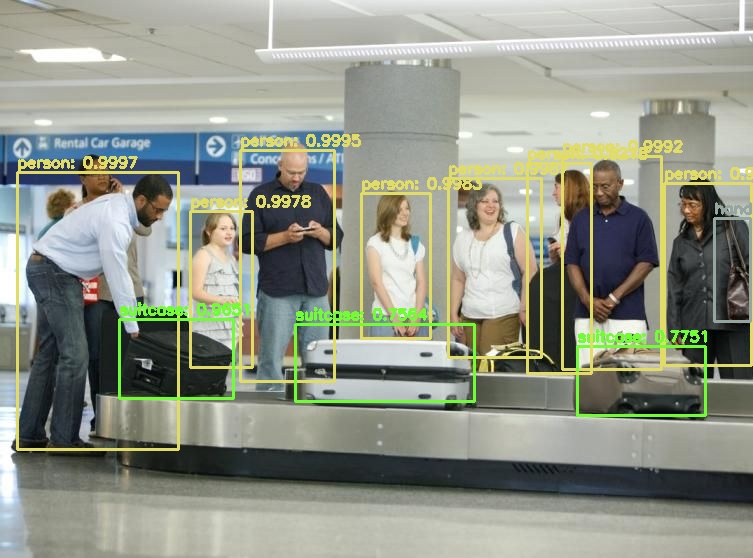YOLO Object Detection with OpenCV
目录
- Object Detection with Image
- Object Detection with Video
这篇文章只是基于OpenCV使用YOLOv3算法执行目标检测;不涉及到YOLOv3的理论原理、不涉及训练过程;也就是说仅仅使用训练好的模型文件基于OpenCV做测试;包括图片和视频;
只用作笔记,原教程地址:YOLO object detection with OpenCV
Object Detection with Image

# 执行方式
# 里面涉及到的文件,可以到原博客地址下载,或者contact me
python yolo_cz.py --image images/baggage_claim.jpg --yolo yolo-coco#!/usr/bin/env python
#-*- coding:utf-8 -*-
# @Time : 19-4-23 下午4:36
# @Author : chen# 一些依赖包
import numpy as np
import argparse
import time
import cv2
import os# 命令行参数解析
ap = argparse.ArgumentParser()
ap.add_argument("-i", "--image", required=True, help="path to input image")
ap.add_argument("-y", "--yolo", required=True, help="base path to YOLO directory")
ap.add_argument("-c", "--confidence", type=float, default=0.5, help="minimum probability to filter weak detections")
ap.add_argument("-t", "--threshold", type=float, default=0.3, help="threshold when applying non-maxima suppression")
args = vars(ap.parse_args())# 加载COCO标签,因为使用YOLOv3的权重文件是在COCO数据集上训练得到的
labelsPath = os.path.sep.join([args["yolo"], "coco.names"])
LABELS = open(labelsPath).read().strip().split("\n")# 初始化一个80*3的数组,数组元素值介于0~255;
# 80表示COOC总共有80个类别;
# 每一行表示一个颜色值,用不同的颜色框出不同类别的物体
np.random.seed(42)
COLORS = np.random.randint(0, 255, size=(len(LABELS), 3), dtype=np.uint8)# YOLOv3训练好的权重文件路径以及网络配置文件路径
weightsPath = os.path.sep.join([args["yolo"], "yolov3.weights"])
configPath = os.path.sep.join([args["yolo"], "yolov3.cfg"])# 加载网络
# 因为权重文件是由Darknet训练得到,使用cv2.dnn.readNetFromDarknet()加载
# opencv中也提供了其他网络模型的加载方法,TensorFlow,Caffe...
print("[INFO] loading YOLO from disk...")
net = cv2.dnn.readNetFromDarknet(configPath, weightsPath)# 读取待检测的图片,并获取其维度信息
image = cv2.imread(args["image"])
(H, W) = image.shape[:2]# 获取输出层的名称: ['yolo_82', 'yolo_94', 'yolo_106']
ln = net.getLayerNames()
ln = [ln[i[0] - 1] for i in net.getUnconnectedOutLayers()]
"""
上面这两句的目的是为了获取输出层的名字
什么意思呢?
先来看net.getLayerNames()与net.getUnconnectedOutLayers()的用法了:
net.getLayerName()用法如其名:获取每一层的名称,返回一个列表,如:[conv_0, bn_0, relu_0, conv_1,..., permut_106, yolo_106]
net.getUnconnectedOutLayers()也可以猜到部分含义:这里Unconnected就是后面没有连接的层了;那么它的作用是以列表的形式返回输出层在整个网络中的索引位置;
上面两行代码含义也就明显了:得到输出是:['yolo_82', 'yolo_94', 'yolo_106']其实,还有一个函数,简单明了,直接一步就得到想要的输出了,就是:
net.getUnconnectedOutLayerNames()
"""# 根据输入图像构造blob
# 好像opencv读取深度网络模型,网络的输入都要转换成blob的形式
blob = cv2.dnn.blobFromImage(image, 1/255.0, (416, 416), swapRB=True, crop=False)# 输入到网络中,并执行前向传播
net.setInput(blob)
start = time.time()
layerOutputs = net.forward(ln)
end = time.time()# 输出一次Inference所用时间
print("[INFO] YOLO took {:.6f} seconds.".format(end - start))"""
layerOutsputs是YOLO算法在图片中检测到的bbx的信息
由于YOLO v3有三个输出,也就是上面提到的['yolo_82', 'yolo_94', 'yolo_106']
因此layerOutsputs是一个长度为3的列表
其中,列表中每一个元素的维度是(num_detection, 85)
num_detections表示该层输出检测到bbx的个数
85:因为该模型在COCO数据集上训练,[5:]表示类别概率;[0:4]表示bbx的位置信息;[5]表示置信度下面要做的就是对网络输出的bbx进行检查:
判定每一个bbx的置信度是否足够的高,以及执行NMS算法去除冗余的bbx
"""# 初始化列表,用以保存bbx的位置信息、类别有关的最大概率值以及对应的索引位置
boxes = []
confidences = []
classIDs = []# 对每个输出层的输出进行迭代
for output in layerOutputs:# 对每一个bbx进行检测for detection in output:scores = detection[5:] # 各类别的概率classID = np.argmax(scores) # 最大概率位置索引confidence = scores[classID] # 最大概率# 判断是否满足人为设定的阈值if confidence > args["confidence"]:# 如果满足,获取bbx的坐标信息box = detection[0:4] * np.array([W, H, W, H])(centerX, centerY, width, height) = box.astype("int")# 计算bbx的坐标信息,bbx左上角点的坐标x = int(centerX - (width/2))y = int(centerY - (height/2))# 更新上面设置的几个列表boxes.append([x, y, int(width), int(height)]) # 原博客中这样写,其实width、height已经是intconfidences.append(float(confidence))classIDs.append(classID)# 上面已经对三个输出层检测到bbx检测完了
# 可以看出,人为设定一个阈值,如果检测到类别概率最大值小于该阈值,则该bbx无效# 经过上一步保留下来的bbx的confidence都是大于人为设定的阈值
# 但是会出现冗余的bbx,即检测到的bbx可以都是一个object
# 所以会使用NMS算法去除重复的检测框
# 有关NMS算法部分,请自行google
idxs = cv2.dnn.NMSBoxes(boxes, confidences, args["confidence"], args["threshold"])
"""
那么idxs返回的是什么呢?
idxs返回的是一个一维数组,其中数组的元素表示保留下来的bbx的索引位置
例如:执行NMS之前bbx有15个,即boxes是一个长度为15的列表idxs中的元素就表示经过NMS算法后,保留下来的bbx在boxes列表中的索引位置
"""# 因此,下面就提取出最后bbx的位置信息,
# 并利用OpenCV将其画到图片上if len(idxs) > 0:# 循环每一个bbxfor i in idxs.flatten():# bbx的坐标信息(x, y) = (boxes[i][0], boxes[i][1])(w, h) = (boxes[i][2], boxes[i][3])# 获取当前bbx所对应的颜色值(还记得最一开始的COLORS吗?就是一个类别对应一种颜色)# 颜色值需要根据classID来确定color = [int(c) for c in COLORS[classIDs[i]]]# 使用OpenCV画矩形cv2.rectangle(image, (x, y), (x + w, y + h), color, 2)# 需要显示在图片上的文本信息text = "{}: {:.4f}".format(LABELS[classIDs[i]], confidences[i])cv2.putText(image, text, (x, y-5), cv2.FONT_HERSHEY_SIMPLEX, 0.5, color, 2)# 显示图片
cv2.imshow("Image", image)
cv2.imwrite("output.jpg", image)
cv2.waitKey(0)Object Detection with Video
# 执行方式
# 里面涉及到的文件,可以到原博客地址下载,或者contact me
python yolo_video_cz.py --input videos/car_chase_01.mp4 --output output/chen.avi --yolo yolo-coco#!/usr/bin/env python
#-*- coding:utf-8 -*-
# @Time : 19-4-23 下午7:34
# @Author : chen"""
基于视频的目标检测的测试和上面基于图像的目标检测原理都是一样的
不同的地方在于,需要从视频中提取每一帧进行目标检测
并将最终检测的结果形成视频保存代码有许多相似之处,不再具体解释"""# 加载依赖包
import numpy as np
import argparse
import imutils
import time
import cv2
import os# 解析命令行参数
ap = argparse.ArgumentParser()
ap.add_argument("-i", "--input", required=True, help="path to input video")
ap.add_argument("-o", "--output", required=True, help="path to output video")
ap.add_argument("-y", "--yolo", required=True, help="base path to YOLO directory")
ap.add_argument("-c", "--confidence", type=float, default=0.5, help="minimum probability to filter weak detections")
ap.add_argument("-t", "--threshold", type=float, default=0.3, help="threshold when applyong non-maxima suppression")
args = vars(ap.parse_args())# 加载COCO数据集标签
labelsPath = os.path.sep.join([args["yolo"], "coco.names"])
LABELS = open(labelsPath).read().strip().split("\n")# 获取颜色值
np.random.seed(42)
COLORS = np.random.randint(0, 255, size=(len(LABELS), 3), dtype="uint8")# 加载YOLO目标检测器
weightsPath = os.path.sep.join([args["yolo"], "yolov3.weights"])
configPath = os.path.sep.join([args["yolo"], "yolov3.cfg"])print("[INFO] loading YOLO from disk...")
net = cv2.dnn.readNetFromDarknet(configPath, weightsPath)
ln = net.getLayerNames()
ln = [ln[i[0] - 1] for i in net.getUnconnectedOutLayers()]# 初始化VideoCapture类
vc = cv2.VideoCapture(args["input"])
writer = None
(W, H) = (None, None)# 获取视频的总的帧数
try:prop = cv2.cv.CV_CAP_PROP_FRAME_COUNT if imutils.is_cv2() \else cv2.CAP_PROP_FRAME_COUNTtotal = int(vc.get(prop))print("[INFO] {} total frames in video".format(total))# an error occurred while trying to determine the total
# number of frames in the video file
except:print("[INFO] could not determine # of frames in video")print("[INFO] no approx. completion time can be provided")total = -1# 循环检测视频中的每一帧
while True:# 读取帧# grabbed是一个bool,表示是否成功捕获帧# frame是捕获的帧(grabbed, frame) = vc.read()# 退出循环if not grabbed:break# 如果W,H为空,获取第一帧的width、heightif W is None or H is None:(H, W) = frame.shape[:2]# 构造blob,并输入到网络中,执行Inferenceblob = cv2.dnn.blobFromImage(frame, 1 / 255.0, (416, 416),swapRB=True, crop=False)net.setInput(blob)start = time.time()layerOutputs = net.forward(ln)end = time.time()# 初始化列表,保存bbx信息boxes = []confidences = []classIDs = []# 循环每一个输出层的输出for output in layerOutputs:# 循环该层输出的每一个bbxfor detection in output:# 获取当前bbx的信息scores = detection[5:]classID = np.argmax(scores)confidence = scores[classID]# 类别最大概率与设定的阈值相比较if confidence > args["confidence"]:# bbx的坐标信息box = detection[0:4] * np.array([W, H, W, H])(centerX, centerY, width, height) = box.astype("int")x = int(centerX - (width / 2))y = int(centerY - (height / 2))# 更新bbx列表boxes.append([x, y, int(width), int(height)])confidences.append(float(confidence))classIDs.append(classID)# 执行NMS算法,去除重复的bbxidxs = cv2.dnn.NMSBoxes(boxes, confidences, args["confidence"], args["threshold"])if len(idxs) > 0:# 循环提取每一个bbx坐标信息,使用OpenCV画在图上for i in idxs.flatten():# bbx坐标信息(x, y) = (boxes[i][0], boxes[i][1])(w, h) = (boxes[i][2], boxes[i][3])# 画出bbxcolor = [int(c) for c in COLORS[classIDs[i]]]cv2.rectangle(frame, (x, y), (x + w, y + h), color, 2)text = "{}: {:.4f}".format(LABELS[classIDs[i]], confidences[i])cv2.putText(frame, text, (x, y - 5), cv2.FONT_HERSHEY_SIMPLEX, 0.5, color, 2)# 检查writer是否为空if writer is None:# 初始化VideoWriteerfourcc = cv2.VideoWriter_fourcc(*"MJPG")writer = cv2.VideoWriter(args["output"], fourcc, 30, (frame.shape[1], frame.shape[0]), True)# 输出处理每一帧的时间,以及处理完视频总的时间if total > 0:elap = (end - start)print("[INFO] single frame took {:.4f} seconds".format(elap))print("[INFO] estimated total time to finish: {:.4f}".format(elap * total))# 写入当前帧writer.write(frame)# 释放文件指针
print("[INFO] cleaning up...")
writer.release()
vc.release()转载于:https://www.cnblogs.com/chenzhen0530/p/10758923.html
YOLO Object Detection with OpenCV相关推荐
- 同r做一个窗口_目标检测(Object Detection):R-CNN/SPPnet/R-FCN/Yolo/SSD
这篇文章我是Survey目标检测(Object Detection)系列论文的一个总结. 包括R-CNN系列.SPP-net.R-FCN.YOLO系列.SSD.DenseBox等. 基本概念 目标识别 ...
- Object Detection(目标检测神文)
目标检测神文,非常全而且持续在更新.转发自:https://handong1587.github.io/deep_learning/2015/10/09/object-detection.html,如 ...
- Object Detection经典代码与文章
转载自Object Detection Papers Deep Neural Networks for Object Detection paper: http://papers.nips.cc/pa ...
- object detection
原地址:https://handong1587.github.io/deep_learning/2015/10/09/object-detection.html Object Detection Pu ...
- 2018_Semantic SLAM Based on Object Detection and Improved Octomap_note
注释 (2022/4/15 上午9:14:24) "ABSTRACT" (Zhang 等., 2018, p. 1) (pdf) 提出了什么: "In this pape ...
- Single shot object detection SSD using MobileNet and OpenCV
微信公众号:小白图像与视觉 关于技术.关注yysilence00.有问题或建议,请公众号留言. 主题:Single shot object detection SSD using MobileNet ...
- 嵌入式目标检测--Fast YOLO: A Fast You Only Look Once System for Real-time Embedded Object Detection
Fast YOLO: A Fast You Only Look Once System for Real-time Embedded Object Detection in Video https:/ ...
- YOLO系列阅读(一) YOLOv1原文阅读:You Only Look Once: Unified, Real-Time Object Detection
目录 0.Abstract 0.1原文翻译 第一段(说明本次研究和之前研究的区别) 第二段(速度快.虽然错误率高一点,但是背景被错误标记的概率更低) 0.2总结 1. Introduction 1.翻 ...
- 目标检测(Object Detection)综述--R-CNN/Fast R-CNN/Faster R-CNN/YOLO/SSD
1. 目标检测 1.1 简介 如何理解一张图片?根据后续任务的需要,有三个主要的层次. 一是分类(Classification),即是将图像结构化为某一类别的信息,用事先确定好的类别(string)或 ...
最新文章
- 【图论专题】最小生成树的扩展应用
- Selenium 爬虫时遇到的问题 Selenium message:session not created
- 上如何刻字_校园石阶上被人刻了1700多个字?!这次网友却说好
- php二维数组中的查找,PHP实现二维数组中的查找算法小结
- 深度学习、图像识别的基本概念
- Haproxy 实现Apache的负载均衡
- Linux——VIM开发C++自动补全(STL、括号)和开发环境配置
- 深度学习图像超分辨率最新综述:从模型到应用
- matplotlib.pyplot.subplot
- [洛谷P1908] 逆序对|归并排序|树状数组
- c++ enum 给定类型_C++ 枚举类型详解
- 阶段性总结、反思、计划
- PHP底层的运行机制与原理
- 修改服务器电脑mac地址,修改服务器电脑mac地址
- 中国地图矫正中的误差
- 什么是VB.NET?
- mqtt 3.1 php代码,MQTT V3.1
- XML采用Boost::regex解析实例
- opencv 简单的裂缝检测
- java drm_Linux DRM那些事-RockPI DRM
